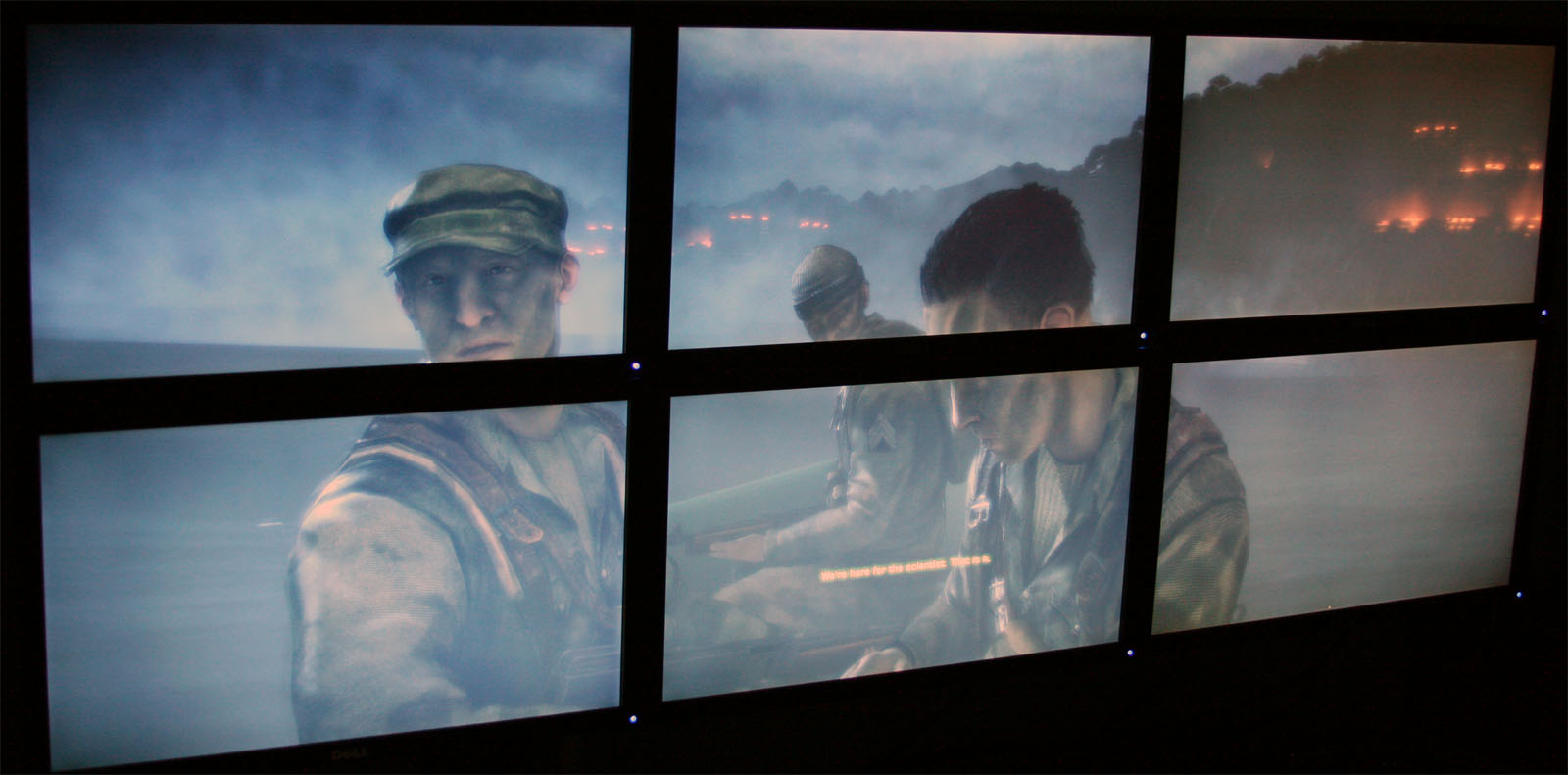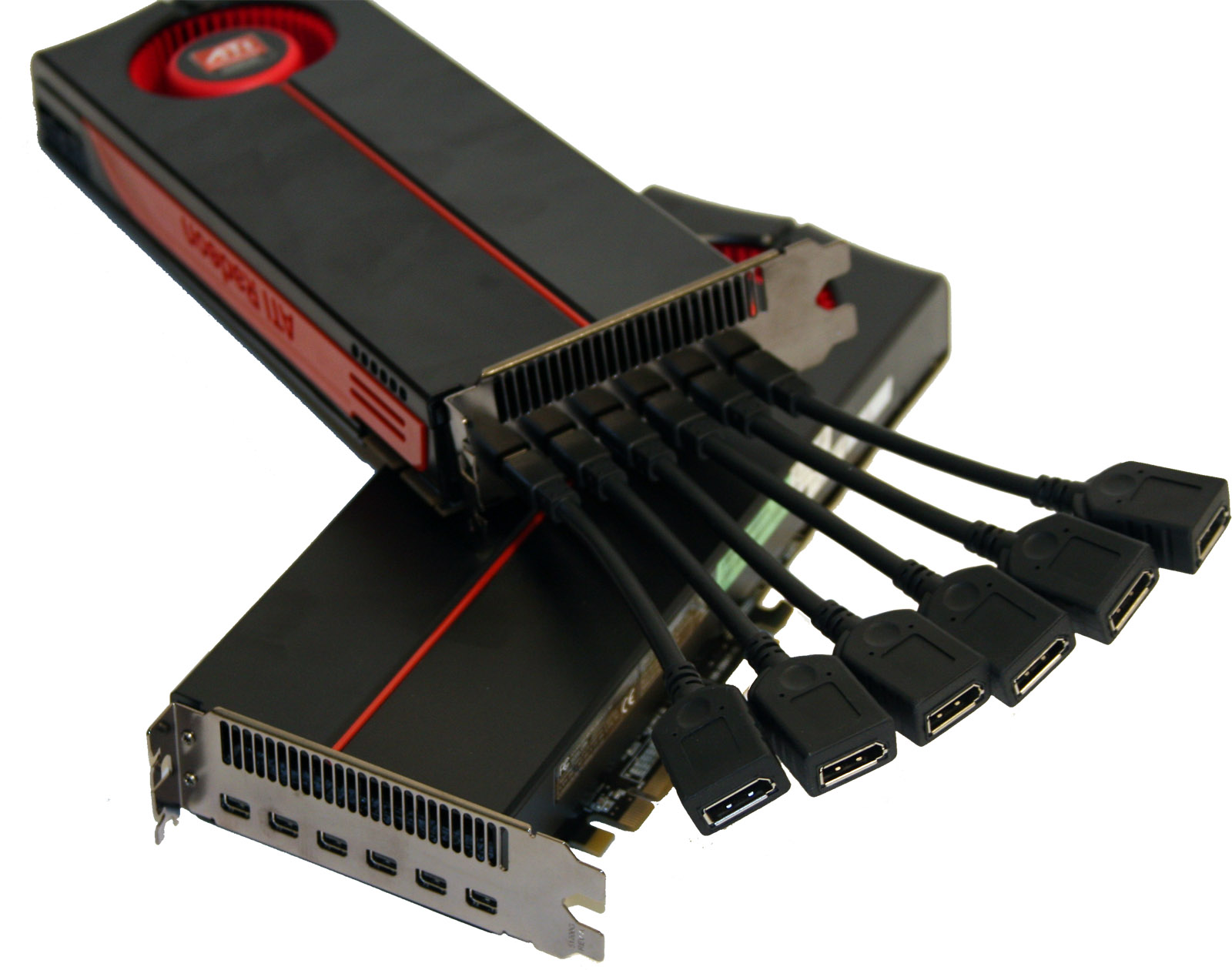AMD Radeon HD 5870 Eyefinity 6 Edition: One Card, Six Screens
Now They're Just Showing Off...
Last week was a mad rush to get Nvidia’s GeForce GTX 480 and 470 tested in sufficient depth to draw some very real conclusions about how the new cards perform in today’s games, how they might fare in the future, and the power they’ll be sucking down in the meantime.
All the while, I knew AMD would be pulling back the curtain on its Radeon HD 5870 Eyefinity 6 Edition today. This card stands in stark contrast to the GeForce GTX 480 as the worst-kept secret ever. AMD was showing it off back in September when it announced the first Radeon HD 5870. Company reps flew around the country last month, dropping six-display setups on tech press like high-res 5760x2160 pixel bombs. Pictures and videos of these jaw-dropping arrangements made their way online, and we got our first taste of what it’d be like to stack LCDs vertically, rather than just spanning horizontally, like most of us multi-monitor proponents do today.
The only thing embargoed up until now was performance data. Over the course of the past six months, AMD’s driver team has been working on the software backing Eyefinity 6. And while all of the kinks still aren’t worked out, setting up and using intricate display configurations is much easier now than it was a month ago when the first Catalyst build landed in our lab.
Eyefinity 6 Lands In The Lab
AMD’s PR team arrived at our SoCal test facility with not one, but two 2GB Radeon HD 5870 Eyefinity 6 Edition boards.
At 11” long, the Eyefinity 6 card is the exact same length as AMD’s reference Radeon HD 5870 1GB. Because it sports a second gigabyte of GDDR5 memory, however, it requires one eight-pin and one six-pin auxiliary power connector (in comparison, the 1GB Radeon HD 5870 employs two six-pin connectors). Idle power creeps up from 27W on the 1GB card to 34W on the 2GB card (according to AMD), and maximum board power ramps up from 188W to 228W—a somewhat-surprising 40W increase.
Why the larger frame buffer? Well, as you likely already know, the Eyefinity 6 card sports six display outputs in the form of Mini DisplayPort connectors. Each output accommodates a resolution up to 2560x1600. Sling six of those together and you’re looking at a 7680x3200 surface—large enough to bring any 1GB card to its knees (and indeed, realistically big enough to drop even this 2GB board below the point of playability).
Get Tom's Hardware's best news and in-depth reviews, straight to your inbox.
| Header Cell - Column 0 | Radeon HD 5870 Eyefinity 6 Edition 2GB | Radeon HD 5870 1GB |
|---|---|---|
| GPU; Process | Cypress; 40nm | Cypress; 40nm |
| Engine Clock | 850 MHz | 850 MHz |
| Stream Processors | 1,600 | 1,600 |
| Memory Type | GDDR5 | GDDR5 |
| Memory Clock / Data Rate | 1,200 MHz / 4,800 Mb/s | 1,200 MHz / 4,800 Mb/s |
| Memory Capacity | 2GB | 1GB |
| Memory Bandwidth | 153.6 GB/s | 153.6 GB/s |
| Maximum Board Power | 228W | 188W |
| Idle Board Power | 34W | 27W |
However, our test setup consists of six 1920x1080 22” Dell P2210H LCDs, adding up to 5760x2160—a more plausible 12.5 million pixels. And we’re going to tax it in several different ways, exploring the difference between a 1GB Radeon HD 5870 and the 2GB Eyefinity 6 Edition card, whether one 2GB card is ample to play across six 22” LCDs, and how much of a boost you might see by running two Eyefinity 6 Edition cards in CrossFire mode.
Sounds like a boatload of “sweet,” right? Dude. Totally. But there are also a handful of caveats to bear in mind. Let’s begin by getting the unpleasant business out of the way first.
Current page: Now They're Just Showing Off...
Next Page Navigating The Obstacle Course-
phantomtrooper I would hate playing with that much black area between screens. I will stick with my 1080p monitor thank you.Reply -
megamanx00 Glad they compared the 1GB and 2GB cards in a 3x1 setup. Glad I got my 5870 instead of waiting for a 2GB card :D. Even so, I want some thin bezel monitors before I hook up three of them. The bezel on my HP LCD is just to think so I'm not keen on buying another two.Reply -
duk3 http://www.newegg.com/Product/Product.aspx?Item=N82E16814125322&cm_re=5870-_-14-125-322-_-ProductReply
Immediate availability? Yes.
Even in stock! (When linked :P ) -
ltcommander_data So I guess Apple's miniDP connector is quite useful after-all and is now seeing adoption outside of Macs.Reply
It's too bad you didn't test GTA IV like you used to do. I believe GTA IV at max settings exceeds 1GB of VRAM usage so perhaps 2GB graphics cards may be of some use assuming the game isn't still CPU limited despite 12 threads with the Core i7 980X. At the very least, I'm guessing Liberty City at 6048x2276 would be amazing. -
oldscotch Obviously, the best solution is a 3x3 grid of displays to make sure your centre focus is not interfered with.Reply
Lesse, that'd be 5760 x 3240.
No sweat ;) -
So, I guess if you already have a 1GB 5870 and 3x1 Eyefinity setup, the only advantage of the 2GB version is being able to pile on the AA/AF effects and still have a playable frame rate.Reply


